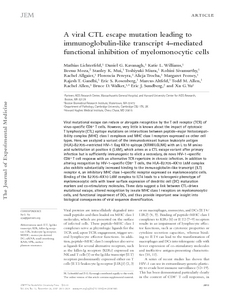Lichterfeld, M;
Kavanagh, DG;
Williams, KL;
Moza, B;
Mui, SK;
Miura, T;
Sivamurthy, R;
Allgaier, R;
Pereyra, F;
Trocha, A;
et al.
Lichterfeld, M; Kavanagh, DG; Williams, KL; Moza, B; Mui, SK; Miura, T; Sivamurthy, R; Allgaier, R; Pereyra, F; Trocha, A; Feeney, M; Gandhi, RT; Rosenberg, ES; Altfeld, M; Allen, TM; Allen, R; Walker, BD; Sundberg, EJ; Yu, XG
(2007)
A viral CTL escape mutation leading to immunoglobulin-like transcript 4-mediated functional inhibition of myelomonocytic cells.
JOURNAL OF EXPERIMENTAL MEDICINE, 204 (12).
2813 - 2824 (12).
ISSN 0022-1007
https://doi.org/10.1084/jem.20061865
SGUL Authors: Allen, Rachel Louise
![[img]](https://openaccess.sgul.ac.uk/1299/1.hassmallThumbnailVersion/jem2042813.pdf)  Preview |
|
["document_typename_application/pdf; charset=binary" not defined]
Published Version
Download (2MB)
| Preview
|
Abstract
Viral mutational escape can reduce or abrogate recognition by the T cell receptor (TCR) of virus-specific CD8+ T cells. However, very little is known about the impact of cytotoxic T lymphocyte (CTL) epitope mutations on interactions between peptide–major histocompatibility complex (MHC) class I complexes and MHC class I receptors expressed on other cell types. Here, we analyzed a variant of the immunodominant human leukocyte antigen (HLA)-B2705–restricted HIV-1 Gag KK10 epitope (KRWIILGLNK) with an L to M amino acid substitution at position 6 (L6M), which arises as a CTL escape variant after primary infection but is sufficiently immunogenic to elicit a secondary, de novo HIV-1–specific CD8+ T cell response with an alternative TCR repertoire in chronic infection. In addition to altering recognition by HIV-1–specific CD8+ T cells, the HLA-B2705–KK10 L6M complex also exhibits substantially increased binding to the immunoglobulin-like transcript (ILT) receptor 4, an inhibitory MHC class I–specific receptor expressed on myelomonocytic cells. Binding of the B2705–KK10 L6M complex to ILT4 leads to a tolerogenic phenotype of myelomonocytic cells with lower surface expression of dendritic cell (DC) maturation markers and co-stimulatory molecules. These data suggest a link between CTL-driven mutational escape, altered recognition by innate MHC class I receptors on myelomonocytic cells, and functional impairment of DCs, and thus provide important new insight into biological consequences of viral sequence diversification
| Item Type: |
Article
|
| Additional Information: |
© 2007 Rockefeller University Press.
Beginning six months after publication, RUP grants the public the non-exclusive right to copy, distribute, or display the Work under a Creative Commons Attribution-Noncommercial-Share Alike 3.0 Unported license, as described at http://creativecommons.org/licenses/by-nc-sa/3.0/ and http://creativecommons.org/licenses/by-nc-sa/3.0/legalcode. |
| Keywords: |
Acquired Immunodeficiency Syndrome, CD8-Positive T-Lymphocytes, HIV, HIV Infections, HLA-B27 Antigen, Histocompatibility Antigens Class I, Humans, Monocytes, Mutation, Myeloid Cells, Receptors, Antigen, T-Cell, T-Lymphocytes, Cytotoxic, Science & Technology, Life Sciences & Biomedicine, Immunology, Medicine, Research & Experimental, Research & Experimental Medicine, CLASS-I MOLECULES, T-LYMPHOCYTE RESPONSE, VIRUS TYPE-1 INFECTION, NATURAL-KILLER-CELLS, DENDRITIC CELLS, HIV-1 INFECTION, IMMUNODEFICIENCY VIRUSES, IMMUNE ESCAPE, HOMOLOG UL18, CUTTING EDGE |
| SGUL Research Institute / Research Centre: |
Academic Structure > Infection and Immunity Research Institute (INII) |
| Journal or Publication Title: |
JOURNAL OF EXPERIMENTAL MEDICINE |
| ISSN: |
0022-1007 |
| Related URLs: |
|
| Web of Science ID: |
WOS:000251320300008 |
| Dates: |
| Date |
Event |
| 2007-11-26 |
Published |
|
  |
Download EPMC Full text (PDF)
|
 |
Download EPMC Full text (HTML)
|
| URI: |
https://openaccess.sgul.ac.uk/id/eprint/1299 |
| Publisher's version: |
https://doi.org/10.1084/jem.20061865 |
Statistics
Item downloaded times since 07 Oct 2014.
Actions (login required)
 |
Edit Item |



